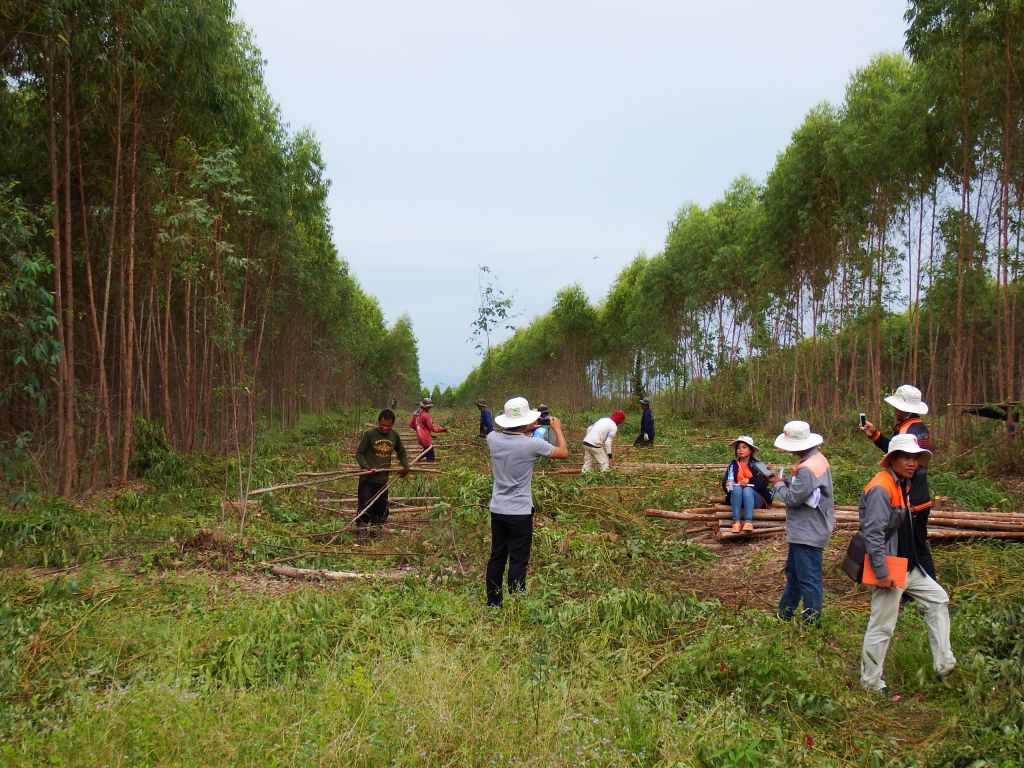Reflecting on Partnership: How can we help the private sector better engage with local communities? A case study from Lao PDR

One of RECOFTC’s core values revolves around engaging multiple actors in a participatory approach to sustainable community forestry, and here at Lao PDR Country Programme (LCP), we have had ample opportunity to prove the effectiveness of such an approach. In recent years, Lao PDR has seen an increase in foreign investment, infrastructure development, and expanding agribusiness production. Consequently, one important stakeholder is often left out of discussions regarding community forestry related initiatives: the private sector.
By not actively engaging with the private sector, we are missing an important opportunity to improve the livelihoods of local communities. Working with the private sector also provides an opportunity to curtail potential harmful business practices that can lead to deforestation. In Lao PDR, however, RECOFTC has managed to successfully engage and take advantage of the private sector’s interest!

For the past ten years, Stora Enso Lao PDR (SEL), a Scandinavian plantation/Agroforestry Company, has been working with local communities in Savannaketh, Saravanh and Khammuan provinces in the south to plant eucalyptus trees on leased and rented land. This is not a small operation either. SEL agroforestry model currently covers a total area of 3,000 ha, which overlaps with approximately 2,350 households in 47 villages and 9 districts. Not only does SEL benefit from this engagement, they also bring benefits to local communities through land leasing, a village development fund, the provision of labour via a plantation model, unexploded ordnance clearing, and rice and other crop production between the tree spaces, whereby trees are planted in rows separated by 9 meters. The Stora Enso model can be seen as a responsible forest business model, which with the support of RECOFTC and local partners can be further scaled up to improve livelihoods for a larger population, including in the areas of gender equality, food security and access to markets.
SEL has often upheld admirable standards when working with local communities, but it was, and still is, set on continuously increasing them. With such a large operation, however, it is often difficult to improve at desired rates. This is where RECOFTC’s specialties have helped so far. As an organization that focuses on capacity development, we were in a suitable position to help SEL’s field staff understand better how the company wants to be perceived, the benefits of working with local communities, and the ways in which the company can better consult and engage positively with communities. To promote this, RECOFTC joined a partnership between SEL and Village Focus International to develop the capacity of SEL. This was graciously supported by MRLG, with advisory services from IFC.
As the common goal of the partnership was to improve and strengthen SEL’s field staff’s capacity to engage with the local communities in the company’s target areas, we followed a genuine participatory approach. This approach included both communities and the field staffs of SEL, focusing on training in the areas of Free, Prior, Informed Consent (FPIC) concepts, facilitation skills, conflict transformation, and value chain development. Partnering together for five sessions, we were able to demonstrate how strengthening social safeguards and ensuring proper methods of consultation and consent can be beneficial to both the community and the business operations. Sessions included interactive training and study tours, workshops, field tests and subsequent coaching sessions.
Our initiative was successful, and we have been able to record favorable progress: “Unlike the old days, right now the team is applying the FPIC process in their target villages,” noted Songkha Latpho, a SEL staff member on the Land Team in Sepon district, Savannaketh. Not only did RECOFTC improve the capacity of SEL’s field staff, but they also improved facilitation skills and community engagement. Mr. Latpho also conveyed this fact: “The decision making process … is now made by the whole communities, including the women, after sufficient information is given by the SEL team.” Now, we are more confident that their trained field staff engages with local communities in a respectful and productive manner, one that takes into account gender roles and includes a more collective approach to the marketing and selling of community products. Finally, as previously noted, this initiative benefited local communities as well. By utilizing participatory measures throughout this partnership and specific communications tools, such as the video on Good Faith Negotiations, the communities were able to better understand SEL business practices and increase their own voices in potential future partnerships. In sum, this initiative helped secure good and fair governance, the right to secure one’s livelihood, and produced sustainable management practices, both from a community and business lens. We are grateful to have contributed to this partnership.
As this initiative has shown, the private sector can benefit from the proper engagement with local peoples. At this very moment, we are discussing how SEL can further their ability to reach out to more communities, diversify crops and livestock, and introduce these communities to new markets. All partners agree that inclusion of local people in value chains will be beneficial for everybody and we are looking forward to finding new ways to improve the quality of life in the region! This partnership between RECOFTC, SEL, VFI, local communities and other civil society organizations working in Laos is one of the many examples of how participatory approaches in community forestry can act as a catalyst for change. By harnessing the skills and perspectives of multiple stakeholders, community forestry is a medium in which our mutual pursuit of equity, sustainable forest management, and a more just society can be realized.

